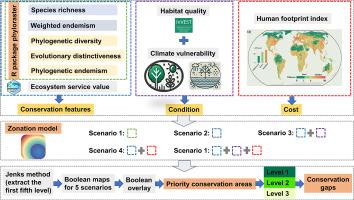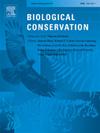Identification of biodiversity priority conservation areas in China by integrating genetic, species and ecosystem diversity
IF 4.9
1区 环境科学与生态学
Q1 BIODIVERSITY CONSERVATION
引用次数: 0
Abstract
Genetic, species, and ecosystem diversity are the three fundamental levels of biodiversity, each crucial for identifying priority conservation areas (PCAs). Globally or regionally, the areas with the highest genetic, species, and ecosystem diversity are not necessarily the same. To comprehensively represent biodiversity, this study fully considers these three fundamental levels from the foundational concept of biodiversity. We applied systematic conservation planning theory to develop an integrated framework for identifying PCAs for key protected species in China. We used species richness (SR), weighted endemism (WE), phylogenetic diversity (PD), evolutionary distinctiveness (ED), phylogenetic endemism (PE), and ecosystem service value (ESV) as conservation indicators and built different scenarios in Zonation. The results show that the total area of PCAs is approximately 3.29 million km2, accounting for about 34.29 % of China's total land area. More than half (approximately 52.21 %) of existing protected areas (PAs) overlap with the PCAs, indicating that current PAs are somewhat effective in biodiversity protection. However, there are still some PCAs that are not located within PAs, suggesting a significant potential for expanding the PAs network. Additionally, the distribution of newly established national park pilot areas aligns well with that of the PCAs, demonstrating the effectiveness of national park policies in protecting biodiversity. This study bridges traditional ecological theory with practical conservation planning, offering new insights into the theoretical methods and practical applications for identifying PCAs. It also provides valuable guidance for the selection and adjustment of PCAs in other regions globally.

综合基因、物种和生态系统多样性,确定中国生物多样性优先保护区
遗传、物种和生态系统多样性是生物多样性的三个基本层面,对于确定优先保护区(PCA)至关重要。在全球或区域范围内,遗传、物种和生态系统多样性最高的地区并不一定相同。为了全面体现生物多样性,本研究从生物多样性的基本概念出发,充分考虑了这三个基本层次。我们运用系统保护规划理论建立了一个综合框架,用于确定中国重点保护物种的 PCA。我们将物种丰富度(SR)、加权特有性(WE)、系统发育多样性(PD)、进化独特性(ED)、系统发育特有性(PE)和生态系统服务价值(ESV)作为保护指标,并在 Zonation 中构建了不同的方案。研究结果表明,PCA 总面积约为 329 万平方公里,约占中国陆地总面积的 34.29%。半数以上(约 52.21%)的现有保护区与保护区重叠,表明现有保护区在一定程度上有效地保护了生物多样性。然而,仍有一些保护区不在保护区内,这表明扩大保护区网络的潜力巨大。此外,新建立的国家公园试点区的分布与保护区的分布十分吻合,表明国家公园政策在保护生物多样性方面的有效性。本研究将传统生态理论与实际保护规划相结合,为确定保护区的理论方法和实际应用提供了新的见解。它还为全球其他地区选择和调整保护区提供了宝贵的指导。
本文章由计算机程序翻译,如有差异,请以英文原文为准。
求助全文
约1分钟内获得全文
求助全文
来源期刊

Biological Conservation
环境科学-环境科学
CiteScore
10.20
自引率
3.40%
发文量
295
审稿时长
61 days
期刊介绍:
Biological Conservation is an international leading journal in the discipline of conservation biology. The journal publishes articles spanning a diverse range of fields that contribute to the biological, sociological, and economic dimensions of conservation and natural resource management. The primary aim of Biological Conservation is the publication of high-quality papers that advance the science and practice of conservation, or which demonstrate the application of conservation principles for natural resource management and policy. Therefore it will be of interest to a broad international readership.
 求助内容:
求助内容: 应助结果提醒方式:
应助结果提醒方式:


